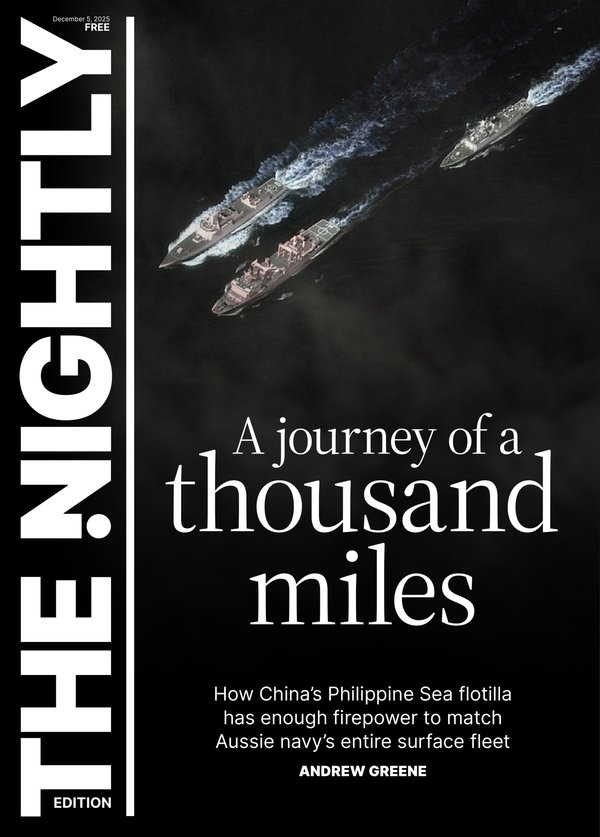Russia targets Ukraine power grid with over 200 missiles ahead of UN nuclear plant inspection
Russia has attacked Ukraine with more than 200 missiles and drones, killing seven people and striking several energy facilities, officials in Kyiv say as the head of the United Nations nuclear watchdog prepares to visit the Kursk nuclear power plant in western Russia
Power cuts and water supply outages were reported in many areas of Ukraine, including parts of Kyiv, as officials said the attack targeted power or other critical infrastructure across the country.
Russia stepped up its strikes on the Ukrainian power grid in March in what Ukraine has said looked like a concerted effort to degrade the system ahead of next winter when people need electricity and heating most.
Sign up to The Nightly's newsletters.
Get the first look at the digital newspaper, curated daily stories and breaking headlines delivered to your inbox.
By continuing you agree to our Terms and Privacy Policy.The air force downed 102 out of 127 incoming missiles and 99 out of 109 drones, Air Force Commander Mykola Oleshchuk said on Telegram, describing the attack from the air, ground and sea as “the most massive” of the war.
According to Prime Minister Denys Shmyhal, 15 regions sustained damage.
President Volodymyr Zelenskiy said there was “a lot of damage in the energy sector”.
Russia’s defence ministry said its forces used high precision weapons to strike important energy infrastructure in Ukraine which it said supported the military-industrial complex.
It listed power substations, gas compressor stations and storage sites for aircraft weapons.
The missile and drone salvo came as Ukraine is claiming new ground in a major cross-border incursion into Russia’s western Kursk region while Russian forces steadily inch forward in Ukraine’s east, closing in on the transport hub of Pokrovsk.
After meeting top officials, Zelenskiy said a decision had been taken to “further strengthen” the Pokrovsk front, which had at least 38 combat clashes on Monday, according to the military.
Ukrainian officials again urged their allies and arms suppliers to allow long-range strikes into Russia.
At least 47 people were injured, including four children, emergency services said.
The regions that reported strikes on power or critical infrastructure included Volyn and Rivne in the northwest, Khmelnytskyi, Lviv and Ivano-Frankivsk in the west, Zhytomyr in the north, Dnipropetrovsk, Kirovohrad and Vinnytsia in central Ukraine, Zaporizhzhia in the southeast and Odesa in the south.
Neighbouring Moldova, whose grid is linked to that of Ukraine, reported small disruptions to its power network.
Ukraine had no powerful long-range weapons at the start of the invasion but has since developed many models of long-range attack drone and used them to hit targets deep inside Russia, ranging from oil refineries to military airfields.
Over the weekend, Zelenskiy said Ukraine had developed a new “drone missile” that had been used to attack Russia and was more powerful and faster than other hardware in Ukraine’s arsenal.
Officials in Russia reported a Ukrainian drone attack overnight.
Four people were injured in the central region of Saratov, where drones hit residential buildings in two cities.
One drone struck a residential high-rise in the city of Saratov and another hit a residential building in the city of Engels, home to a military airfield that had been attacked before, local officials said.
Both Russia and Ukraine deny deliberately targeting civilians.
Each says its attacks are aimed at destroying infrastructure critical to the other’s war effort.
International Atomic Energy Agency Rafael Grossi said he will lead a team visiting the the Kursk nuclear power plant in western Russia on Tuesday.
The facility is about 30km away from the fighting that erupted nearly three weeks ago when Ukrainian forces launched a surprise incursion into Russian territory.
“Given the serious situation, I am personally leading the International Atomic Energy Agency (IAEA) mission to the Kursk Nuclear Power Plant (KNPP) in the Russian Federation,” Rafael Grossi said in a statement.
“The safety and security of all nuclear power plants is of central and fundamental concern to the IAEA.”
The nuclear power plant is located on the Seym river near the town of Kurchatov.
Last week, Russia told the IAEA that a drone had been intercepted near the plant.
Russian President Vladimir Putin accused Ukraine of an attempted attack on the site.
Grossi has visited the Russian-occupied Ukrainian nuclear power plant in Zaporizhzhia several times and even stationed an IAEA team there.
The permanent presence of the international experts not only serves as a way to monitor the situation but also to deter hostilities that could trigger a nuclear accident.
with DPA with AP
